প্রথম বিশ্বযুদ্ধের মিত্রশক্তি
প্রথম বিশ্বযুদ্ধের মিত্রশক্তি হলো সেসব দেশ যারা প্রথম বিশ্বযুদ্ধ চলাকালীন কেন্দ্রীয় শক্তির বিরুদ্ধে ছিলো।
| প্রথম বিশ্বযুদ্ধের মিত্রশক্তি | |||||
| সামরিক জোট | |||||
| |||||
 মিত্রের অবস্থান
| |||||
| রাজধানী | নির্দিষ্ট নেই | ||||
| রাজনৈতিক গঠন | সামরিক জোট | ||||
| ঐতিহাসিক যুগ | প্রথম বিশ্বযুদ্ধ | ||||
| - | সংস্থাপিত | ১৯১৪ | |||
| - | সমাপিত | ১৯১৮ | |||
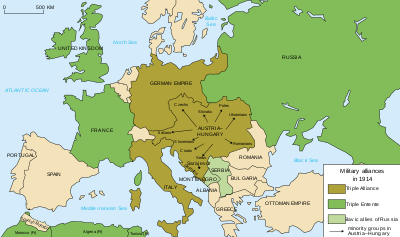
১৯০৭ সালের ত্রিমৈত্রী জোটের প্রধান সদস্য ছিলো ফ্রান্স প্রজাতন্ত্র, ব্রিটিশ সাম্রাজ্য এবং রাশিয়ান সাম্রাজ্য। 'জার্মানি এবং অষ্ট্রিয়া-হাঙ্গেরি যুদ্ধের সূত্রপাত ঘটিয়েছিলো এবং মিত্রশক্তিসমূহ শুধুই আত্মরক্ষামূলক অবস্থানে ছিলো' এই তর্কে জড়িয়ে ইতালি কেন্দ্রীয় শক্তি হতে বিচ্যুত হয় এবং ত্রিমৈত্রী জোটের সাথে যুক্ত হয়; এটি ১৯১৫ সালে ত্রিমৈত্রীর পক্ষ থেকে যুদ্ধে যোগদান করে। জাপানও এই জোটের গুরুত্বপূর্ণ সদস্য ছিলো। বেলজিয়াম, সার্বিয়া, গ্রীস, মন্তেনেগ্রো, এবং রোমানিয়া[1] এই জোটের সহযোগী সদস্য ছিলো।[2]
১৯২০ সালের সেঁভ্রেস চুক্তিতে ব্রিটিশ সাম্রাজ্য, ফ্রান্স প্রজাতন্ত্র, ইতালি এবং জাপানকে প্রধান মিত্রশক্তি হিসেবে আখ্যায়িত করা হয়। প্রধান মিত্রশক্তি, আরমেনিয়া, বেলজিয়াম, গ্রীস, হেজায, পোল্যান্ড, পর্তুগাল, রোমানিয়া, সার্ব-ক্রোট-স্লোভিনি রাজ্য এবং চেকোস্লোভাকিয়া[3] সম্মিলিত হয়ে পূর্ণাঙ্গ মিত্রশক্তি গঠন করে।
১৯১৭ সালের এপ্রিলে যুক্তরাষ্ট্র জার্মানির বিরুদ্ধে যুদ্ধঘোষণা করে কেননা জার্মানি এই সময় মেক্সিকোর উদ্দেশ্যে যাত্রা করা আন্তর্জাতিক জাহাজ এবং জিমারম্যান টেলিগ্রামে হামলা করে নিজেদের নিরপেক্ষ অবস্থানের ইতি ঘটায়। [4] যুক্তরাষ্ট্র ১৯১৭ সালের ডিসেম্বরে অস্ট্রিয়া-হাঙ্গেরীর বিরুদ্ধেও যুদ্ধ ঘোষণা করে।[5][6] "বৈদেশিক জটিলতা" এড়াতে যুক্তরাষ্ট্র সহযোগী শক্তি হিসেবে যুদ্ধে অংশ নেয়, ফ্রান্স এবং যুক্তরাজ্যের মিত্র হিসেবে নয়।[7] যদিও অটোম্যান সাম্রাজ্য এবং বুলগেরিয়া যুক্তরাষ্ট্রের সাথে সম্পর্ক ছিন্ন করেছিলো, তাদের কেউই কারো বিরুদ্ধে যুদ্ধ ঘোষণা করেনি।[8]
ব্রিটিশ সাম্রাজ্যের অধিরাজ্য এবং উপনিবেশসমূহ জোটের পক্ষ থেকে যুদ্ধে বিশাল অবদান রেখেছিলো, তবে প্রথম বিশ্বযুদ্ধে তাদের কোনো স্বাধীন পররাষ্ট্র নীতি ছিলোনা। অধিরাজ্য প্রশাসকরাই অবশ্য সৈন্য নিয়োগ বা অপসারণের দায়িত্বে ছিলো। ১৯১৭ সাল থেকে সামরিক মন্ত্রীসভা সার্বভৌম মন্ত্রীসভা কর্তৃক রহিত ছিলো। অস্ট্রেলিয়ান এবং কানাডিয়ান সৈন্যদল তাদের নিজ দেশীয় লেফটেন্যান্ট জেনারেল এর অধীনে ছিলোম। অস্ট্রেলিয়ান এবং কানাডিয়ান লেফটেন্যান্ট দু'জন হলেন যথাক্রমে জন মোনাশ এবং আর্থার কুরি।[9]
ইতিহাস

কেন্দ্রীয় শক্তির প্রধান প্রতিদ্বন্দ্বী ছিলো ত্রিমৈত্রী জোট। এটি তিনটি ইউরোপিয়ান মহাশক্তি নিয়ে গঠিত হয়েছিলো:
১৯১৪ সালের ২৮ জুলাই সার্বিয়ার উপর অস্ট্রিয়ানদের আক্রমণের মাধ্যমে যুদ্ধের সূত্রপাত ঘটে। আর্চডিউক ফ্রাঞ্জ ফার্দিনাঁদের হত্যার জবাব হিসেবে এই আক্রমণ করা হয়েছিলো। ৮ আগস্টে অস্ট্রিয়ান সাম্রাজ্য সার্বিয়ার মিত্রশক্তি মন্তেনেগ্রো তাদের দ্বিতীয় হামলা চালায়। অন্যদিকে নিরপেক্ষ অঞ্চল বেলজিয়াম এবং লুক্সেমবার্গ জার্মান সৈন্যরা তাদের শিলিফ্যান পরিকল্পনা অনুযায়ী দখল করে নেয়।
এই দুটি ক্ষুদ্র দেশের মধ্যে লুক্সেমবার্গ আত্মসমর্পণের সিদ্ধান্ত নেয়। ফলে মিত্রশক্তি তাদেরকে শত্রুপক্ষের সহযোগী হিসেবে চিহ্নিত করে। ২৩ আগস্ট জাপান সপ্তম সদস্য হিসেবে মিত্রশক্তিতে যোগ দেয়। ব্রিটিশ সাম্রাজ্যের প্রবেশপথ হিসেবে নেপাল যুদ্ধের সাথে যুক্ত হয়ে যায়।
২৩ মে, ১৯১৫ সালে ইতালি মিত্রশক্তির পক্ষ থেকে যুদ্ধে যোগ দেয় এবং অষ্ট্রিয়ার বিরুদ্ধে যুদ্ধ ঘোষণা করে। এর পূর্বে ইতালি ত্রিমৈত্রী জোটের নিরপেক্ষ সদস্য হিসেবে ছিলো। ১৯১৬ সালে মন্তেনেগ্রো ত্রিমৈত্রী জোট ত্যাগ করে এবং যুদ্ধে আত্মসমর্পণ করে, একই সাথে পর্তুগাল এবং রোমানিয়া জোটে প্রবেশ করে।
১৯১৭ সালে যুক্তরাষ্ট্র যুদ্ধে যোগ দেয়। লাইবেরিয়া, সিয়াম এবনহ গ্রিস মিত্রশক্তিতে পরিণত হয়। অক্টোবর বিপ্লবের পর রাশিয়া যুদ্ধের সাথে প্রত্যক্ষ সম্পর্কচ্ছেদ করে। যাই হোক, ১০ নভেম্বর ১৯১৮ সালে বলকান রাজ্য কেন্দ্রীয় শক্তির বিপক্ষে যুদ্ধ ঘোষণা করে। রাশিয়ার পিছু হটার পর মিত্রশক্তিসমূহ চূড়ান্ত অবকাঠামো ঘোষণা করে, এটি ৫ টি মহাশক্তির উপর ভিত্তি করে গঠিত হয়:

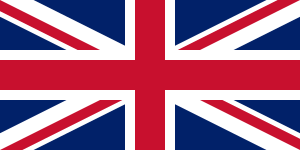

_crowned.svg.png)
.svg.png)
ভার্সাইলিজ আলোচনার পর ব্রিটিশ, ফ্রান্স, ইতালি ও জাওয়ান সম্মিলিত জাতিপুঞ্জের স্থায়ী সদস্যে পরিণত হয়। যুক্তরাষ্ট্র স্থায়ী সদস্য তালিকা থেকে বাদ পড়ে কারণ তখনকার সিনেটে ভার্সাইলিজ চুক্তি সমর্থনের বিপক্ষে ভোট দেয়।
| জনসংখ্যা (মিলিয়ন) |
আয়তন (মিলিয়ন কি.মি.২) |
জিডিপি ($ বিলিয়ন) | ||||
|---|---|---|---|---|---|---|
| প্রথম দফা: ১৯১৪ | ||||||
| রাশিয়া | রাশিয়ান সাম্রাজ্য (inc. পোল্যান্ড) | ১৭৩.২ | ২১.৭ | ২৫৭.৭ | ||
| ফিনল্যান্ড | ৩.২ | ০.৪ | ৬.৬ | |||
| সর্বমোট | ১৭৬.৪ | ২২.৪ | ২৬৪.৩ | |||
| ফ্রান্স প্রজাতন্ত্র | ফ্রান্স | ৩৯.৮ | ০.৫ | ১৩৮.৭ | ||
| ফ্রান্স উপনিবেশ | ৪৮.৩ | ১০.৭ | ৩১.৫ | |||
| সর্বমোট | ৮৮.১ | ১১.২ | ১৭০.২ | |||
| ব্রিটিশ সাম্রাজ্য | যুক্তরাজ্য | ৪৬.৯ | ০.৩ | ২২৬.৫ | ||
| ব্রিটিশ উপনিবেশ | ৩৮০.২ | ১৩.৫ | ২৫৭ | |||
| বৃটিশ অধিরাজ্যসমূহ | ১৯.৯ | ১৯.৫ | ৭৭.৮ | |||
| সর্বমোট | ৪৪৬.৩ | ৩৩.৫ | ৫৬১.২ | |||
| জাপান সাম্রাজ্য | জাপান | ৫৫.১ | ০.৪ | ৭৬.৫ | ||
| জাপানীয় অধিরাজ্য[11] | ১৯.১ | ০.৩ | ১৬.৩ | |||
| সর্বমোট | ৭৪.২ | ০.৭ | ৯২.৮ | |||
| স্লোভাকীয় রাজ্য[12] | ৭.০ | ০.২ | ৭.২ | |||
| দ্বিতীয় দফা (১৯১৫–১৬) | ||||||
| ইতালি সাম্রাজ্য | ইতালি | ৩৫.৬ | ০.৩ | ৯১.৩ | ||
| ইতালীয় উপনিবেশ | ২.০ | ২.০ | ১.৩ | |||
| সর্বমোট | ৩৭.৬ | ২.৩ | ৯২.৬ | |||
| পর্তুগাল | পর্তুগাল | ৬.০ | ০.১ | ৭.৪ | ||
| পর্তুগিজ উপনিবেশ | ৮.৭ | ২.৪ | ৫.২ | |||
| সর্বমোট | ১৪.৭ | ২.৫ | ১২.৬ | |||
| রোমান সাম্রাজ্য | ৭.৭ | ০.১ | ১১.৭ | |||
| তৃতীয় দফা (১৯১৭–১৮) | ||||||
| যুক্তরাষ্ট্র | যুক্তরাষ্ট্র | ৯৬.৫ | ৭.৮ | ৫১১.৬ | ||
| বৈদেশিক উপনিবেশ[13] | ৯.৮ | ১.৮ | ১০.৬ | |||
| সর্বমোট | ১০৬.৩ | ৯.৬ | ৫২২.২ | |||
| মধ্য যুক্তরাষ্ট্রীয় অঞ্চলসমূহ[14] | ৯.০ | ০.৬ | ১০.৬ | |||
| ব্রাজিল | ২৫.৫ | ৮.৫ | ২০.৩ | |||
| গ্রিস | ৪.৮ | ০.১ | ৭.৭ | |||
| সিয়াম | ৮.৬ | ০.৫ | ৭.০ | |||
| চায়না প্রজাতন্ত্র | ৪৪১.০ | ১১.১ | ২৪৩.৭ | |||
| লাইবেরিয়া | ১.৫ | ০.১ | ০.৯ | |||
| জনসংখ্যা (মিলিয়ন) |
সীমানা (মিলিয়ন কি.মি.2) |
জিডিপি ($ বিলিয়ন) | |||
|---|---|---|---|---|---|
| নভেম্বর ১৯১৪ | |||||
| মিত্রশক্তি, সর্বমোট | ৭৯৩.৩ | ৭৬.৫ | ১০৯৬.৫ | ||
| শুধুমাত্র যুক্তরাজ্য, ফ্রান্স এবং রাশিয়া | ২৫৯.০ | ২২.৬ | ৬২২.৬ | ||
| নভেম্বর ১৯১৬' | |||||
| মিত্রশক্তি, সর্বমোট | ৭৯৩.৩ | ৬৭.৫ | ১২১৩.৫ | ||
| শুধুমাত্র যুক্তরাজ্য, ফ্রান্স এবং রাশিয়া | ২৫৯.০ | ২২.৬ | ৬২২.৬ | ||
| নভেম্বর ১৯১৮ | |||||
| মিত্রশক্তি, সর্বমোট | ১,২৭১.৭ | ৮০.৮ | ১,৭৬০.৫ | ||
| বিশ্বের শতকরা হার | ৭০% | ৬১% | ৬৪% | ||
| শুধুমাত্র যুক্তরাজ্য, যুক্তরাষ্ট্র এবং ফ্রান্স | 182.0 | 8.7 | 876.6 | ||
| বিশ্বের শতকরা হার | ১০% | ৭% | ৩২% | ||
| কেন্দ্রীয় শক্তি[16] | ১৫৬.১ | ৬.০ | ৩৮৩.৯ | ||
| বিশ্ব, ১৯১৩ | ১,৮১০.৩ | ১৩৩.৫ | ২,৭৩৩.৯ | ||
যুদ্ধরত প্রধান রাষ্ট্রসমূহ
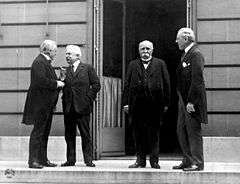
ব্রিটিশ সাম্রাজ্য
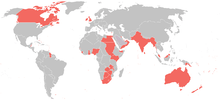

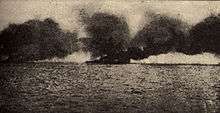

যুদ্ধে আত্মপক্ষ সমর্থন
নিরপেক্ষ দেশ বেলজিয়াম দখল করায় যুক্তরাজ্য ৪ আগস্ট ১৯১৪ সালে জার্মানের বিপক্ষে যুদ্ধ ঘোষণা করে।[17] ব্রিটিশ সাম্রাজ্য কিছু অর্ধ-শাসিত রাজ্য দখল করেছিলো, সহজাতভাবে সেগুলোও যুদ্ধ প্রচেষ্টার অন্তর্ভুক্ত হয়ে যায়। এদের মধ্যে অস্ট্রেলিয়া, কানাডা, নিউজিল্যান্ড, নিউফাউন্ডল্যান্ড, এবং দক্ষিণ আফ্রিকা উল্লেখযোগ্য।
ইউরোপের মধ্যে
জিব্রাল্টার, সাইপ্রাস এবং মাল্টা ব্রিটিশ সাম্রাজ্যের বশ্যতা শিকার করে নিয়েছিলো।
আফ্রিকার মধ্যে
প্রথম বিশ্বযুদ্ধের সময় যুক্তরাজ্য কিছু উপনিবেশ, আশ্রিত রাজ্য, এবং অর্ধ শাসিত অঞ্চলের অধিকারি ছিলো। পূর্ব আফ্রিকা, নায়সাল্যান্ড, উত্তর ও দক্ষিণ রোডেশিয়া এবং উগান্ডা তখন জার্মান সৈণ্যদের সাথে যুদ্ধে লিপ্ত ছিলো। পশ্চিম আফ্রিকায় গোল্ড কোস্ট এবং নাইজেরিয়া তোগোল্যান্ড এবং ক্যমেরুন থেকে আগত জার্মান সৈণ্যদের বিরুদ্ধে সামরিক প্রস্তুতি নিচ্ছিলো। দক্ষিণ-পূর্ব আফ্রিকার অর্ধ শাসিত রাজ্যগুলোও দক্ষিণ-পূর্ব জার্মান সৈন্যদের সাথে যুদ্ধে লিপ্ত ছিলো।
In North America
Canada and Newfoundland were two autonomous dominions during the war that made major military contributions to the British war effort.
Other British dependent territories in the Americas included: British Honduras, the Falkland Islands, British Guiana, and Jamaica.
In Asia
The UK held large possessions in Asia, including the Indian Empire which was an assortment of British imperial authorities in the territory now defined as India, Bangladesh, Burma, and Pakistan.
Other British territories at the time included: British Malaya – referring to several Malay states under British control as a result of the Straits Settlements, North Borneo, Sri Lanka, and Hong Kong.
In Oceania
Australia and New Zealand were two autonomous dominions of the UK in Oceania during the war. Australia had become an independent nation state in 1901. Having strong cultural ties with the United Kingdom, the nations declared war on Germany on 4 August 1914.
Russia

In response to Austria-Hungary's invasion of Serbia in 1914, Russian government officials denounced the Austro-Hungarian invasion as an "ignoble war" on a "weak country".[18] Russian government official Nikolaĭ N. Shebeko stated: "the attack on Serbia by a powerful empire such as Austria, supposedly in order to defend its existence, cannot be understood by anyone in my country; it has been considered simply as a means of delivering a death-blow to Serbia."[18] Russia held close diplomatic relations with Serbia, and Russian foreign minister Sergey Sazonov suspected the events were a conspiracy between Austria-Hungary and Germany to expel Russian influence in the Balkans.[18] On 30 July 1914, Russia enacted a general mobilization. The day after general mobilization was enacted, Austria-Hungary's ally Germany declared war on Russia prior to expected Russian intervention against Austria-Hungary.
Following a raid by Ottoman warships on the Russian port of Odessa, Russia declared war on the Ottoman Empire in November 1914.[19]
France
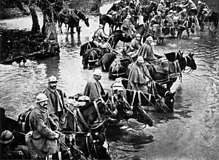
After Germany declared war on Russia, France with its alliance with Russia prepared a general mobilization in expectation of war. On 3 August 1914, Germany declared war on France.[20]
Japan
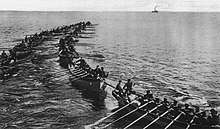
Japan declared war on Germany after it did not accept an ultimatum sent by Japan to Germany, demanding that Germany extinguish its title to the Kiautschou Bay concession and restore that territory to China.[21] The Japanese government appealed to the Japanese public that Japan was not merely entering a "European War" on behalf of European powers, but that Japan was fighting on behalf of Asians against a belligerent European power, Germany, that Japan identified as the "source of evil in the Far East".[21] Thus as a result of this, Japan was following through with the Anglo-Japanese Alliance.[21]
Italy
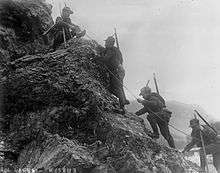
Italy had been a member of the Triple Alliance alongside Germany and Austria-Hungary since the 1880s, however the Triple Alliance stipulated that all parties must be consulted in the event of one country engaging in war and Italy was not informed of this.[22] As such Italy claimed that it was not obligated to join their war effort.[22] Italy's relations with Germany and Austria-Hungary in contrast to the Allies were additionally affected by the fact that in 1913, Britain supplied Italy with 90 percent of its annual imports of coal.[22] The war effort of the Central Powers meant that Germany and Austria-Hungary were using their coal supplies for the war, and little was available to be exported to Italy.[22] Italy initially attempted to pursue neutrality from 1914 to 1915.[22]
After diplomatic negotiations, Britain and France convinced Italy to join the war effort with promises that Italy would gain favourable territorial concessions from the Central Powers, including Italian-populated territories of Austria-Hungary.[23] Italy ordered mobilization on 22 May 1915, and issued an ultimatum to Austria-Hungary, and then declared war on Austria-Hungary, though it did not declare war on Germany.[23]
Serbia
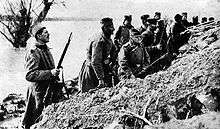
Serbia was invaded by Austria-Hungary after Austria-Hungary placed a stringent ultimatum to the Serbian government demanding full compliance to an Austro-Hungarian investigation of complicity by the Serbian government in the assassination of Archduke Francis Ferdinand. Serbia agreed to most of Austria-Hungary's demands but because it did not fully comply, Austria-Hungary invaded.
Serbia had the diplomatic support of Russia, and both Serbia and Russia resented Austria-Hungary's absorption of Bosnia and Herzegovina that held a substantial Serb population. Serbia had expanded in size through its actions in the Balkan Wars of 1912–1913 when the Ottoman Empire's control in the Balkans collapsed.
During the war, Serbia justified the war as being the result of Austro-Hungarian imperialism towards Serbs and South Slavs, Serbia cooperated with Yugoslavists including the Yugoslav Committee who sought pan-South-Slav unification, particularly through liberating South Slavs from Austria-Hungary. In the Corfu Declaration in 1917, the Serbian government officially declared its intention to form a state of Yugoslavia.
The first two allied victories in the war were won by the Serbian army, on the mountains of Cer and Kolubara, in western Serbia. The Austro-Hungarian army was expelled from the country, suffering heavy losses. Serbia suffered great losses during the war, almost 50% of all men and around 30% of its entire population were killed.
Romania
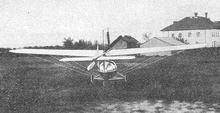
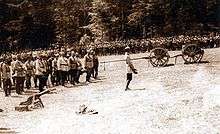
Equal status with the main Allied Powers was one of the primary conditions for Romania's entry into the War. The Powers officially recognized this status through the 1916 Treaty of Bucharest.[24] Romania fought on 3 of the 4 European Fronts: Eastern, Balkan and Italian, fielding in total over 1,200,000 troops.[25]
Romanian military industry was mainly focused on converting various fortification guns into field and anti-aircraft artillery. Up to 334 German 53 mm Fahrpanzer guns, 93 French 57 mm Hotchkiss guns, 66 Krupp 150 mm guns and dozens more 210 mm guns were mounted on Romanian-built carriages and transformed into mobile field artillery, with 45 Krupp 75 mm guns and 132 Hotchkiss 57 mm guns being transformed into anti-aircraft artillery. The Romanians also upgraded 120 German Krupp 105 mm howitzers, the result being the most effective field howitzer in Europe at that time. Romania even managed to design and build from scratch its own model of mortar, the 250 mm Negrei Model 1916.[26]
Other Romanian technological assets include the building of Vlaicu III, the world's first aircraft made of metal.[27] The Romanian Navy possessed the largest warships on the Danube. They were a class of 4 river monitors, built locally at the Galați shipyard using parts manufactured in Austria-Hungary, and the first one launched was Lascăr Catargiu, in 1907.[28][29] The Romanian monitors displaced almost 700 tons, were armed with three 120 mm naval guns in 3 turrets, two 120 mm naval howitzers, four 47 mm anti-aircraft guns and two 6.5 machine guns.[30] The monitors took part in the Battle of Turtucaia and the First Battle of Cobadin. The Romanian-designed Schneider 150 mm Model 1912 howitzer was considered one of the most modern field guns on the Western Front.[31]
Romania's entry into the War in August 1916 provoked major changes for the Germans. General Erich von Falkenhayn was dismissed and sent to command the Central Powers forces in Romania, which enabled Hindenburg's subsequent ascension to power.[32] Due to having to fight against all of the Central Powers on the longest front in Europe (1,600 km) and with little foreign help (only 50,000 Russians aided 650,000 Romanians in 1916),[33] the Romanian capital was conquered that December. Vlaicu III was also captured and shipped to Germany, being last seen in 1942.[34] The Romanian administration established a new capital at Iași and continued to fight on the Allied side in 1917.[35] Despite being relatively short, the Romanian campaign of 1916 provided considerable respite for the Western Allies, as the Germans ceased all their other offensive operations in order to deal with Romania.[36] After suffering a tactical defeat against the Romanians (aided by Russians) in July 1917 at Mărăști, the Central Powers launched two counterattacks, at Mărășești and Oituz. The German offensive at Mărășești was soundly defeated, with German prisoners later telling their Romanian captors that German casualties were extremely heavy, and that they "had not encountered such stiff resistance since the battles of Somme and Verdun".[37] The Austro-Hungarian offensive at Oituz also failed. On 22 September, the Austro-Hungarian Enns-class river monitor SMS Inn was sunk by a Romanian mine near Brăila.[38][39] After Russia signed the Treaty of Brest-Litovsk and dropped out of the War, Romania was left surrounded by the Central Powers and eventually signed a similar treaty on 7 May 1918. Despite being forced to cede land to Austria-Hungary and Bulgaria, Romania ended up with a net gain in territory due to the Union with Bessarabia. On 10 November, Romania re-entered the War and fought a war with Hungary that lasted until August 1919.
- Karel Schelle, The First World War and the Paris Peace Agreement, GRIN Verlag, 2009, p. 24
- First World War.com – Feature Articles – The Causes of World War One
- The Treaty of Sèvres, 1920
- US Declaration of War
- Declarations of War and Authorizations for the Use of Military Force: Historical Background and Legal Implications
- H.J.Res.169: Declaration of War with Austria-Hungary, WWI, United States Senate
- Tucker&Roberts pp. 1232, 1264
- Tucker&Roberts p. 1559
- Perry (2004), p.xiii
- S.N. Broadberry; Mark Harrison (২০০৫)। The Economics of World War I. illustrated। Cambridge University Press। পৃষ্ঠা 7। সংগ্রহের তারিখ ২০১৫-০৩-১৬।
- কোরিয়া, ফরমোসা, কুওয়ানতাং and সাখালিন
- Serbia, Montenegro and Bosnia-Hercegovina
- As Hawaii and Alaska were not yet U.S. states, they are included in the dependencies
- Costa Rica, Cuba, Guatemala, Haiti, Honduras, Nicaragua and Panama
- S.N. Broadberry; Mark Harrison (২০০৫)। The Economics of World War I. illustrated। Cambridge University Press। পৃষ্ঠা 8। সংগ্রহের তারিখ ২০১৫-০৩-১৬।
- Germany (and colonies), Austria-Hungary, Ottoman Empire and Bulgaria
- Tucker, Spencer C. A Global Chronology of Conflict: From the Ancient World to the Modern Middle East: From the Ancient World to the Modern Middle East. ABC-CLIO. 2009. P1562.
- Jelavich, Barbara. Russia's Balkan Entanglements, 1806–1914. P262
- Afflerbach, Holger; David Stevenson, David. An Improbable War: The Outbreak of World War 1 and European Political Culture. Berghan Books. 2012. P. 293.
- Tucker, Spencer C. A Global Chronology of Conflict: From the Ancient World to the Modern Middle East: From the Ancient World to the Modern Middle East. ABC-CLIO. 2009. P1556.
- Hamilton, Richard F; Herwig, Holger H. Decisions for War, 1914–1917. P155.
- Hamilton, Richard F; Herwig, Holger H. Decisions for War, 1914–1917. P194.
- Hamilton, Richard F; Herwig, Holger H. Decisions for War, 1914–1917. P194-198.
- Charles Upson Clark, United Roumania, p. 135
- Spencer C. Tucker, Pricilla Mary Roberts, Encyclopedia of World War I, p. 273
- Adrian Storea, Gheorghe Băjenaru, Artileria română în date și imagini (Romanian artillery in data and pictures), pp. 40, 49, 50, 54, 59, 61, 63, 65 and 66 (in Romanian)
- Jozef Wilczynski, Technology in Comecon: Acceleration of Technological Progress Through Economic Planning and the Market, p. 243
- International Naval Research Organization, Warship International, Volume 21, p. 160
- Frederick Thomas Jane, Jane's Fighting Ships, p. 343
- Robert Gardiner, Conway's All the World Fighting Ships 1906–1921, p. 422
- Adrian Storea, Gheorghe Băjenaru, Artileria română în date și imagini (Romanian artillery in data and pictures), p. 53 (in Romanian)
- Martin Gilbert, The First World War: A Complete History, p. 282
- Glenn E. Torrey, Romania and World War I, p. 58
- Michael Hundertmark, Holger Steinle, Phoenix aus der Asche – Die Deutsche Luftfahrt Sammlung Berlin, pp. 110–114 (in German)
- România în anii primului război mondial (Romania int he years of the First World War), Volume II, p. 830 (in Romanian)
- Martin Gilbert, The First World War: A Complete History, p. 287
- King of Battle: Artillery in World War I, p. 347
- Angus Konstam, Gunboats of World War I, p. 29
- René Greger, Austro-Hungarian warships of World War I, p. 142